The third-generation Corvette is perhaps the most overlooked model of all ‘Vette styles. Despite being saddled with carrying the Corvette nameplate through the smog years, some of the earlier models were factory-equipped with decent small- and big-block engine options.
In today’s article, we’ll focus on a 1969 Corvette stuffed with a Tri-Power 427 cubic-inch big-block engine that produced 435 horsepower upon delivery. We’re going to release the sound and fury in the chambers by installing a set of Doug’s Headers sidemount headers and exhaust pipes. Not only do they offer good looks and easy installation, but they also provide the legendary Doug’s Headers performance and sound.
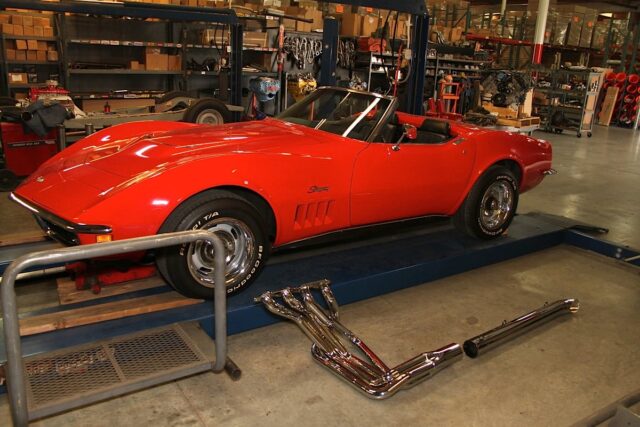
Find C3 Corvette Side Pipes, Big and Small
Doug’s offers C3 Corvette side pipes to fit both the small- and big-block Corvette from 1963 to 1982, with appropriate variations in tubing size and dimension for the various engine styles. All of the part numbers feature 3/8-inch thick flanges to provide solid sealing characteristics, and all tubing is constructed from 16-gauge steel.
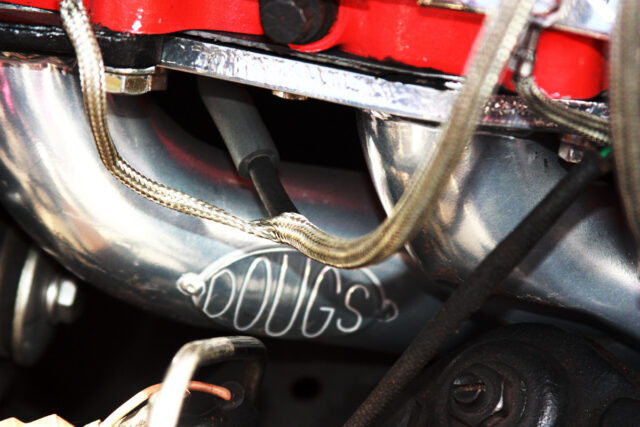
Select a Premium Side-mount Exhaust System
The Doug’s Headers C3 Corvette side pipes are at the premium end of the spectrum; these aren’t your garden-variety headers welded up by a guy working out of his home garage. “Our difference comes down to quality—we use a 3/8-inch thick flange, the gaskets are a premium HTX material, and we even buy the tubing direct from the mills. In addition, after we bend each tube, each tube is hand-polished to remove any stress risers or grip marks that might exist because of the bending process before it is coated or chromed. All of these things help the product to look better and last longer,” said Don Lindfors, Doug’s Exhaust R&D Manager.
Finishes to Fit Your Style
The small-block side exhaust kits come with a standard metallic ceramic thermal barrier finish [322402], but are also offered in black hi-heat finish [323915] and chrome [323902]. Small block headers feature 1 7/8-inch primary tubes and fit all of the 327 and 350 cubic inch engines. The chrome big-block header kit that we used in our installation [323912] have much larger 2 1/8-inch primaries and fit all big-block engines from 396 to 454 cubic inches in the C3 body style. The big-block headers are also available in metallic ceramic [322059] and hi-heat black [323907] finishes.
Aesthetic Appeal Meets Practicality
“The tube-routing design of these headers was actually done way back in the early ’70′s, and they were made for a road-race team to be able to get a good-sized exhaust on the car since the Corvette’s stock tunnel doesn’t really provide room for exhaust to run under the car,” Lindfors explained. “It wasn’t a cosmetic decision at the time; it was really designed to be able to get a big free-flowing system on a lowered, road-race car.”
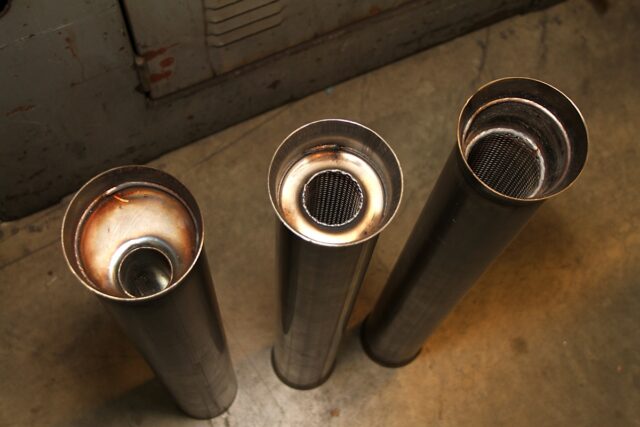
Muffler Options for C3 Corvette Side Pipes
The 4-inch diameter C3 Corvette side pipes are also offered in all three finish styles [D930, D930-B, D930-C], and they bolt to the existing holes in the Corvette’s rocker panel. They are a clamp-fit to either the small- or big-block headers, and three different muffler inserts are available. The standard glass pack insert [D950] offers a throaty sound but quiets down the engine’s output level to keep the folks in your HOA happy, while the high-flow glasspack [D952] offers—yep, you guessed it!—higher flow, and an accompanying sound increase to go along with it. For the sound conscious, the reverse-flow muffler option [D951] controls the most noise.
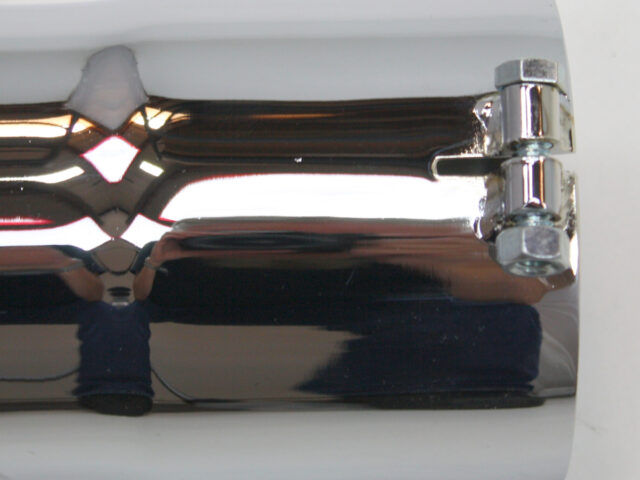
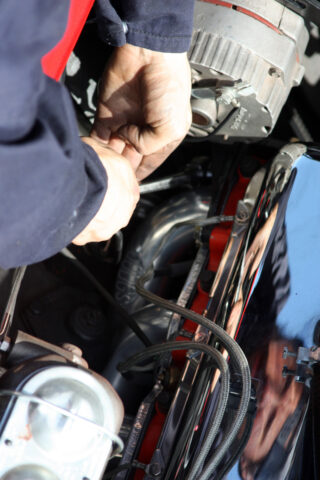
Installation is Easier Than You’d Think
We headed down to the Doug’s Headers R&D facility in Irwindale, California, to follow along with the installation of the complete system on Greg Raymond’s gorgeous red ’69 Convertible C3. Installation of the complete system is fairly simple—almost before we had the camera out, the guys were just about done with installing the headers. Then, it was on to the C3 Corvette side pipes, which didn’t take much longer. “This system is much simpler to install than you’d ever believe by just looking at the header. Removal of the manifolds on both small- and big-block engines in this Corvette generation is pretty simple, and because of the way these headers slip up from the bottom, it slides in there real easy,” Lindfors explained.
Since there is plenty of room to work with in the chassis for the headers, which pop into place from underneath the car, the biggest struggle (which actually wasn’t much of one) was getting the exhaust manifold gaskets lined up and in place. Greg selected the standard glasspack mufflers, which clamp to the collectors and take a few minutes to wiggle into place. A couple of heat-resistant isolators are used to attach the C3 Corvette side pipes to the existing holes in the Corvette’s rocker panels, and that’s about it. Within a couple of hours over an afternoon, new life has been breathed into this C3.
Development work is a tedious process, but the Doug’s Headers team keeps a couple of goals in mind when producing a new set of headers for a specific application. “Whenever we design a header, we bring the car in, and it will generally tell you where it wants the tubes to be because you’re working with limited space,” Lindfors said.
“What we do from there is figure out how to use the lengths and diameters that we need and try to optimize all of those lengths so that they are as close to equal as possible in each application. Of course, it’s important to remember that every time you put a bend in the tube, it changes the effective length of the tube because it slows down the flow. Airflow is laminar—it wants to go straight, and as soon as you start bending it, it wants to slow down. We have to look at all of those things to make sure we achieve the goals we are looking for,” Lindfors explained.
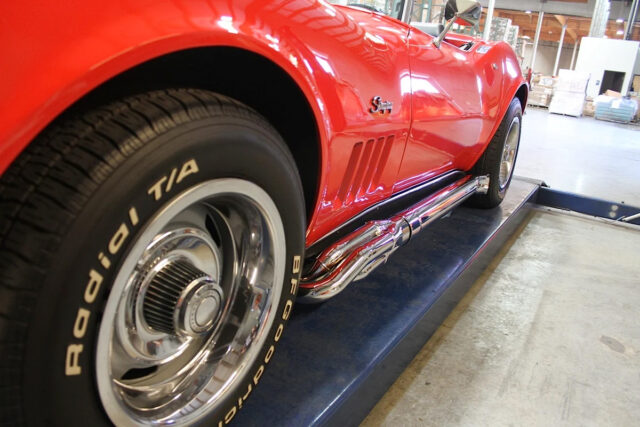
Achieving Superior Sound and Performance
“The whole install could be done in three or four hours.” —Don Lindfors, Doug’s Headers
We got a chance to borrow the car after it had yet another swap and was wearing the matte black version of the side pipes with the D952 Maximum Flow inserts—the least restrictive (and loudest) of the three silencer choices. Here’s what it sounds like:
Owner Greg Raymond couldn’t be happier with the way these C3 Corvette side pipes sound and perform, and we think they make an already gorgeous car even better looking with that glorious splash of chrome setting off the deep red color of the Corvette.
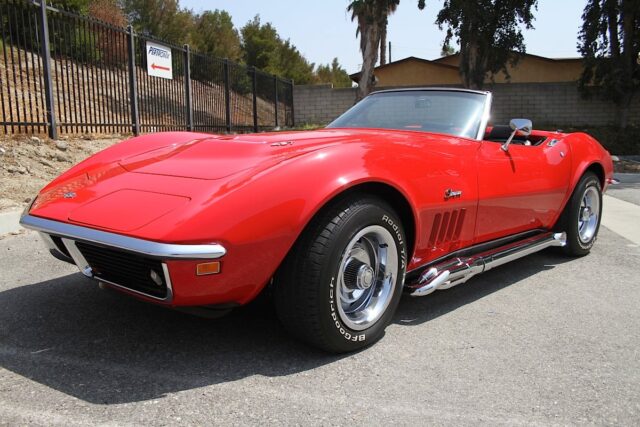
Get Started on Your C3 Corvette Side Pipes Project
Give your ride an upgrade with C3 Corvette side pipes, headers, mufflers, and other exhaust system parts. You can find these high-quality parts from Doug’s Headers at Corvette Central. If you’ve got questions, contact the helpful techs at Corvette Central. You’ll be cruising with a new look and sound in no time.
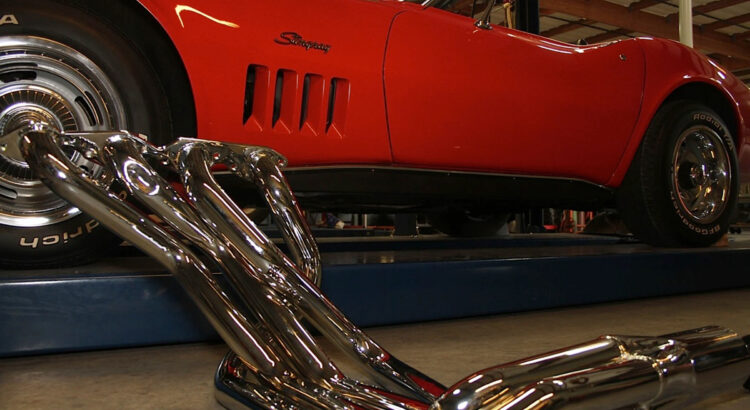
Dougs use to make header side pipes for 67-69 camaro is it possible to find a set ?
It would probably be best to contact Doug’s directly regarding this. You can find them at http://www.pertronix.com .
Hi. I have a 73 corvette running a 454 with automatic box with dart heads, cast iron with rectangle exhaust ports. I,ve had couple different pipes they hit here and there?. would like to buy some sidepipes . but worried they may not fit . can u advise me thanks.
These are not for use with “angle plug” heads. I know Dart has numerous different heads. If your Dart heads are straight plug design, these will most likely work fine. If they are angle plug, they will most likely hit.
I already have Doug 381-c headers for my 68 427/4sp – Vettez06 no A/C. Original motor, Doug’s installation instructions indicate to purchase a different alternator bracket, P/N H7606? Is that correct?
Not a Z06’! Typo only
Just purchased a set of side pipe Doug headers for my 80 vette. Looking forward to the install. Headers on first, then purchase the side pipes. For a nice (not too loud) muffler, what’s a good one? Thanks
1970 Big block installation? Does the rocker have to be notched at the front?
Also is their a stand-off heat shield to prevent barbecued legs? For black side pipes, can the headers be black? I can’t allow chrome headers on the engine my baby left St. Louis with.
Thanks for your time and your long devotion to drag racing. DOUG’S is a no apologies legendary name in racing.
(the black sure would look good on my silver 4sp convertible.)
Yes, if its a factory side pipe car then it will have to be notched. We do offer them in black here is the link https://https://www.corvettecentral.com/search?CurrentSearchCategoryId=&q=323907 and we do offer a few different styles of exhaust shields; here is a link to one that we offer https://https://www.corvettecentral.com/search?CurrentSearchCategoryId=&q=323031
It would be nice if the ridiculous bolt for the clamp was relocated to underside as it is quite an eyesore sitting proud between the rocker and the pipes. I am still looking for a fix.
Does Doug’s make a set for 1982 crossfire vette? I think it needs a bung for the O2 sensor.
We offer a Side mount exhaust kit by Doug’s Headers for 1963-1982 https://https://www.corvettecentral.com/search?CurrentSearchCategoryId=&q=322402
I’m looking for the same thing. Could you let me know if you figured something out please?
Do Dougs Headers make a set of c3 side mount with an LS motor
At this time all that’s been manufactured is LS conversion exhaust systems with Magnaflow mufflers. Here is a link to the different options https://https://www.corvettecentral.com/search?CurrentSearchCategoryId=&q=ls+conversion
Can I install this on my C3 zz4 crate motor without a lift, or can I do it with simply floor jacks?
Yes you can install this system without having a car lift.
I have a 1980 corvette—350 balanced and blueprinted—and I want to install side pipes with headers. Looking for loud and good sounding system. What do you have or recommend?
If you’re looking for the louder aftermarket sound at a budget price, I would recommend Doug’s Headers.
Hi. They look real nice. Do you make a kit for c3 Corvette small block 1 3/4 headers tube?
We currently carry a variety of Doug’s Headers kits and if you have any other questions about measurements or what may fit, please feel free to give our Product Assistance team a call at (800) 345-4122
Hi. I’ve been asking anyone who would listen for help for more time than I can remember. In the 70’s you could buy these header mufflers for a (1960 corvette ), almost any speed shop or magazine had advertisements listing them for sale. Now,I cant even obtain any information on the subject. No one will go through the time involved looking for any info!! J.C. Whitney catalog had them at one time , every call I made, to any distributor or manufacturing company…. another dead end.. Hopefully, someone out there can shed some light on the subject…. at the time, one of my friends purchased a set for his 1959 .looked great, never thought this would be a problem, what do I know. Again thanks for listening.
Unfortunately we don’t offer a side mount exhaust for a C1 Corvette.